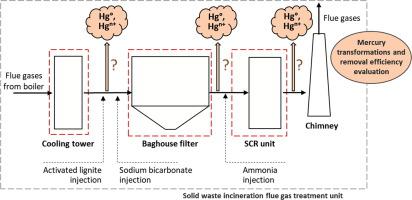Waste Management ( IF 7.1 ) Pub Date : 2020-06-16 , DOI: 10.1016/j.wasman.2020.06.003 Lina M Romero 1 , Nathalie Lyczko 1 , Ange Nzihou 1 , Gérard Antonini 2 , Eric Moreau 3 , Hubert Richardeau 4 , Christophe Coste 5 , Saïd Madoui 6 , Sylvain Durécu 7

|
Modeling approaches are generally used to describe mercury transformations in a single step of flue gas treatment processes. However, less attention has been given to the interactions between the different process stages. Accordingly, the mercury removal performance of a full-scale solid waste incineration plant, equipped with a dry flue gas treatment line was investigated using two complementary modeling strategies: a thermochemical equilibrium approach to study the mercury transformation mechanisms and speciation in the flue gas, and a kinetic approach to describe the mercury adsorption process. The modeling observations were then compared to real-operation full-scale data. Considering the typical flue gas composition of waste incineration facilities (high concentrations of HCl compared to Hg), it was found that a process temperature decrease results in better mercury removal efficiencies, associated with a higher oxidation extent of Hg in HgCl2, and the enhancement of the sorbent capacity. Improvements can also be attained by increasing the sorbent injection rate to the process, or the solid/gas separation cycles. An empirical correlation to predict the mercury removal efficiency from the main operating parameters of dry flue gas treatment units was proposed, representing a useful tool for waste incineration facilities. The presented modeling approach proved to be suitable to evaluate the behavior of full-scale gas treatment units, and properly select the most adequate adjustments in operating parameters, in order to respect the increasingly constraining mercury emissions regulations.
中文翻译:

大规模市政垃圾焚烧烟气处理装置中汞减排和建模的新见解。
通常使用建模方法来描述烟气处理过程中的一步中的汞转化。但是,很少关注不同过程阶段之间的交互。因此,采用两种互补的建模策略研究了配备了干法烟气处理线的大型固体垃圾焚烧厂的除汞性能:一种热化学平衡方法,用于研究烟气中汞的转化机理和形态;以及一种描述汞吸附过程的动力学方法。然后将建模观察结果与实际操作的全面数据进行比较。考虑到废物焚化设施的典型烟气成分(与汞相比,高浓度的HCl),2,提高了吸附能力。还可以通过增加工艺中的吸附剂注入速率或固/气分离循环来实现改进。提出了一种经验相关性,可根据干烟气处理装置的主要运行参数预测脱汞效率,这是废物焚烧设施的有用工具。所提出的建模方法被证明是适合于评价的全规模的气体处理装置的行为,并适当选择操作参数的最适当的调整,以尊重日益制约汞的排放法规。











































 京公网安备 11010802027423号
京公网安备 11010802027423号